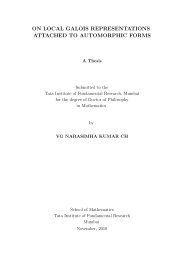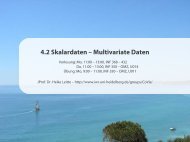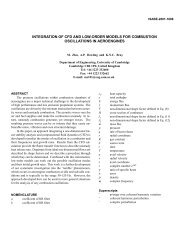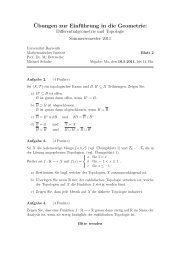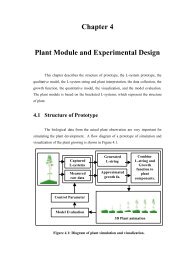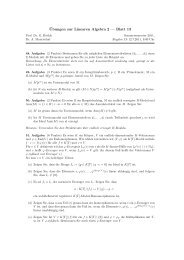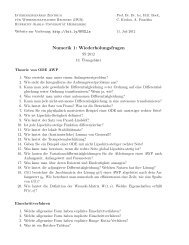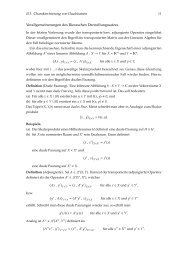Spatially-averaged model for plasma etch processes ... - IWR
Spatially-averaged model for plasma etch processes ... - IWR
Spatially-averaged model for plasma etch processes ... - IWR
Create successful ePaper yourself
Turn your PDF publications into a flip-book with our unique Google optimized e-Paper software.
<strong>Spatially</strong>-<strong>averaged</strong> <strong>model</strong> <strong>for</strong> <strong>plasma</strong> <strong>etch</strong> <strong>processes</strong>: Comparison<br />
of different approaches to electron kinetics<br />
P. Ahlrichs, U. Riedel, a) and J. Warnatz<br />
Interdisziplinäres Zentrum für Wissenschaftliches Rechnen, Universität Heidelberg, Im Neuenheimer Feld<br />
368, D-69120 Heidelberg, Germany<br />
Received 30 September 1997; accepted 8 December 1997<br />
A well stirred reactor <strong>model</strong> determines spatially <strong>averaged</strong> species composition in a <strong>plasma</strong> <strong>etch</strong><br />
reactor by solving conservation equations <strong>for</strong> species, mass, and electron energy distribution<br />
function EEDF. The reactor is characterized by a chamber volume, surface area, mass flow,<br />
pressure, power deposition, and composition of the feed gas. The well stirred reactor <strong>model</strong> is<br />
increasingly common in the literature due to its low requirement of computer resources <strong>for</strong> detailed<br />
chemical kinetics calculations. In such <strong>plasma</strong> <strong>etch</strong> <strong>model</strong>s, assumptions on the EEDF, which are<br />
needed to determine reaction rate coefficients <strong>for</strong> electron impact reactions, are crucial <strong>for</strong> a<br />
prediction of steady state conditions. In this article we focus on a comparison <strong>for</strong> three different<br />
levels of sophistication with regard to the electron energy distribution function: obtaining the EEDF<br />
from a fully coupled solution of species equations and the Boltzmann equation, pre-computing and<br />
tabulating the EEDF <strong>for</strong> typical reactor conditions, and assuming a Maxwellian EEDF. The<br />
influence of these <strong>model</strong>ing assumptions on the steady state conditions of the reactor is examined by<br />
various parametric studies <strong>for</strong> a chlorine <strong>plasma</strong>. The results clearly indicate limitations of the two<br />
simplified approaches to electron kinetics. To summarize, in this article we show the feasibility of<br />
a zero-dimensional <strong>model</strong> which predicts steady state reactor conditions from a fully coupled<br />
solution of Boltzmann and species equations. © 1998 American Vacuum Society.<br />
S0734-21019851403-0<br />
I. INTRODUCTION<br />
Plasma processing is widely used in micro-device fabrication,<br />
where two key steps are deposition and <strong>etch</strong>ing of<br />
material layers on wafer surfaces. Usually, low-pressure gas<br />
discharges are used to dissociate and ionize a feed gas <strong>for</strong> the<br />
purpose of reactive ion <strong>etch</strong>ing. 1,2 Such <strong>plasma</strong> reactors<br />
show a complex behavior due to the coupling of electrodynamic<br />
interaction, fluid dynamics, and chemical reactions in<br />
the gas phase and on the surface. 3 In this article, we focus on<br />
the chemical kinetics in the gas phase, in order to understand<br />
chemical reaction mechanisms and calculate the corresponding<br />
reaction rates. For this purpose it is sufficient to consider<br />
a zero-dimensional 0D <strong>plasma</strong> reactor <strong>model</strong> which can be<br />
used easily as a sub-<strong>model</strong> <strong>for</strong> spatially resolved reactor<br />
simulations.<br />
0D or spatially <strong>averaged</strong> reactor <strong>model</strong>s are common <strong>for</strong><br />
thermal systems 4,5 and, in the last few years, also <strong>for</strong> <strong>plasma</strong><br />
systems. 1,6–9 The major advantage of a 0D <strong>model</strong> lies in the<br />
small computational demands <strong>for</strong> solving the conservation<br />
equations of the system, allowing analysis of the effects of<br />
<strong>model</strong> assumptions or to determine the dependence of the<br />
<strong>plasma</strong> composition on the various input parameters.<br />
The electron energy distribution function EEDF <strong>for</strong> such<br />
systems is under intense investigation 7,9,10 as it is crucial <strong>for</strong><br />
the determination of rates of electron impact in the <strong>plasma</strong><br />
via cross sections. In general, in a low-pressure partially ionized<br />
<strong>plasma</strong> the EEDF is non-Maxwellian. Thus, several approaches<br />
have been made to incorporate this effect into 0D<br />
II. DESCRIPTION OF THE MODEL<br />
The conservation equations of the well stirred reactor<br />
<strong>model</strong> are well known, but some important modifications are<br />
necessary to integrate the solution of Boltzmann’s equation<br />
into this <strong>model</strong>. There<strong>for</strong>e, in the following sections the complete<br />
set of conservation equations is rewritten in a <strong>for</strong>m<br />
suitable <strong>for</strong> the full coupling of electron energy distribution<br />
function and heavy species conservation equations.<br />
We consider a <strong>plasma</strong> chamber of volume V and surface<br />
A in which a <strong>plasma</strong> state is maintained. A steady flow of N g<br />
reactants ṁ 0 with mass fractions Y 0 j ( j1,...,N g ) and temperature<br />
T 0 enters the reactor chamber at a given pressure p.<br />
The state of the well-stirred reactor is given by a neutral<br />
temperature T, an ion temperature T ion , an EEDF f e ()d,<br />
and mass fractions Y j ( j1,...,N g ) of the heavy species.<br />
The surface is characterized by a site density , surface tema<br />
Electronic mail: riedel@iwr.uni-heidelberg.de<br />
<strong>model</strong>s: precalculation of the nonequilibrium EEDF, 9 full<br />
coupling of the EEDF calculation and the heavy species conservation<br />
equations, 11 both by solving Boltzmann’s equation<br />
BE <strong>for</strong> the EEDF, or Monte Carlo calculations of the<br />
EEDF. 7 With regard to spatially resolved simulations it is<br />
desirable to precalculate the EEDF and tabulate or fit the<br />
results to save CPU time, but the error made by this procedure<br />
has not been examined yet.<br />
In this work we use a mathematical <strong>model</strong> of a Cl 2 gas<br />
discharge, consisting of species conservation equations and<br />
the Boltzmann equation to yield the state of the system. We<br />
examine the effect of different approaches to the EEDF on<br />
the results by various parametric studies.<br />
1560 J. Vac. Sci. Technol. A 16„3…, May/Jun 1998 0734-2101/98/16„3…/1560/6/$15.00 ©1998 American Vacuum Society 1560
1561 Ahlrichs, Riedel, and Warnatz : <strong>Spatially</strong>-<strong>averaged</strong> <strong>model</strong> <strong>for</strong> <strong>plasma</strong> <strong>etch</strong> <strong>processes</strong> 1561<br />
perature T s and fractional coverage i (i1,...,N s ) of the<br />
N s surface species. The mass flow to the outlet can be calculated<br />
from ṁ 0 and the reactor pressure p by means of the<br />
continuity equation.<br />
A. Governing equations<br />
We use species conservation equations to calculate the<br />
heavy species mass fractions. Gas-phase conservation yields 9<br />
ṡ j M j A˙ jM j V<br />
V Y N<br />
j<br />
t ṁ0 Y 0 j Y j Y j<br />
g<br />
k1<br />
ṡ k M k A<br />
and surface species conservation<br />
i<br />
ṡ i i<br />
t ,<br />
with being the mass density, ṡ i the molar rate of <strong>for</strong>mation<br />
of species i due to surface reactions, M k the molar mass, and<br />
˙ j the molar rate of <strong>for</strong>mation due to gas-phase reactions.<br />
At the present stage of the <strong>model</strong>, we set the heavy species<br />
and the ion temperature constant rather than solving two<br />
energy equations, due to the lack of knowledge of collision<br />
frequencies between ions and neutral particles. 8<br />
In this work we focus on the treatment of electrons. It is<br />
well known that in high-density, low-pressure <strong>plasma</strong>s, electrons<br />
in general are not in thermal equilibrium. An accurate<br />
treatment of the electrons can be achieved by solving BE <strong>for</strong><br />
the EEDF. 12 The EEDF calculation must be coupled to the<br />
<strong>plasma</strong> conditions such as ionization degree or composition<br />
of heavy species and the electrodynamics. We follow the<br />
approach of Morgan 13 <strong>for</strong> solving the BE numerically in<br />
terms of a two-term spherical harmonic expansion: 14<br />
f e v e ,,t f 0 v e ,t f 1 v e ,tcos ,<br />
where is the angle between the electric field and the velocity<br />
of the electrons. This is a widely used approximation<br />
which holds <strong>for</strong> small E/n gas ratios and elastic cross sections<br />
much larger than inelastic cross sections. 10 The second assumption<br />
is that ac effects can be neglected in the calculation<br />
of the EEDF, if one is interested in the <strong>plasma</strong> composition<br />
<strong>averaged</strong> over one ac cycle and not in the modulation of the<br />
EEDF during the cycle. There<strong>for</strong>e we replace the actual ac<br />
field by an effective dc field which transfers the same power<br />
to the electrons. The advantage of this approach is that one<br />
does not have to resolve an ac cycle in the EEDF calculations,<br />
leading to larger time steps in the numerical solution.<br />
The validity of this approximation is discussed in detail in<br />
Refs. 10, 15, and 16.<br />
In Ref. 15 a Fourier expansion of the distribution function<br />
is per<strong>for</strong>med. The authors conclude that independent of the<br />
degree of nonstationarity of f 1 the period average of the<br />
isotropic distribution f 0 can be sufficiently calculated by the<br />
lowest equation in the Fourier expansion in the case of sinusoidal<br />
electric fields, if the following two conditions <strong>for</strong> the<br />
energy relaxation frequency hold: 16<br />
1<br />
2<br />
3<br />
2 m e<br />
M m and <br />
k<br />
k inel , 4<br />
with (m) being the mole-fraction-<strong>averaged</strong> momentum<br />
(inel)<br />
transfer collision frequency <strong>for</strong> elastic collisions and k<br />
the energy transfer frequency <strong>for</strong> ineleastic collisions, respectively<br />
and m e the electron mass and M the heavy particle<br />
mass. Their lowest equation of the Fourier expansion is identical<br />
to the steady state limit of Eq. 5 of our approach to<br />
solve Boltzmann’s equation <strong>for</strong> an effective dc field.<br />
Low-pressure high-density discharges such as inductively<br />
coupled <strong>plasma</strong>s ICPs or electron cyclotron resonances<br />
ECRs are normally driven by frequencies of 13.56 MHz or<br />
2.45 GHz, respectively. In this frequency regime and <strong>for</strong> the<br />
low system pressures of interest both of the above conditions<br />
hold. There<strong>for</strong>e, we restrict the EEDF calculations to the dc<br />
case, leading to the simplification 14<br />
f 1 v e ,t<br />
eE f 0 v e ,t<br />
, 5<br />
m e m v e<br />
E being the electric field and e the absolute value of the<br />
electron’s charge. This implies that no magnetic fields are<br />
considered. 10 The next assumption is that super-elastic collisions<br />
do not play any role, whereas electron–electron collisions<br />
must be considered cf. below. Under these assumptions,<br />
the BE can be written as 13<br />
f e<br />
t J f<br />
J el<br />
f e<br />
t<br />
<br />
e–e<br />
f e<br />
t<br />
inel<br />
, 6<br />
the index 0 is dropped <strong>for</strong> convenience with the contribution<br />
of the electric field<br />
J f E<br />
7<br />
2<br />
2e<br />
n gas<br />
2 <br />
of elastic collisions<br />
32/m e 1/2 m /n gas<br />
n gas f e<br />
2 f e<br />
<br />
,<br />
J el 2<br />
N g<br />
2m e<br />
m ie <br />
e1/2<br />
M i<br />
i<br />
m<br />
f e kT 2 kT f e<br />
,<br />
and of inelastic collisions<br />
<br />
N N<br />
f e<br />
t<br />
<br />
g li<br />
n<br />
inel<br />
ie<br />
i R ik ik f e ik R ik f e ,<br />
k<br />
9<br />
with<br />
R ik 2 inel ik ,<br />
10<br />
inel<br />
ik<br />
1/2<br />
m e<br />
8<br />
being the cross section <strong>for</strong> the kth inelastic collision<br />
process of electrons with species i. N li is the total number of<br />
inelastic collision <strong>processes</strong> of electrons with species i. The<br />
contribution of electron–electron collisions can be calculated<br />
through the Fokker–Planck equation using the Rosenbluth<br />
potentials: 12<br />
JVST A - Vacuum, Surfaces, and Films
1562 Ahlrichs, Riedel, and Warnatz : <strong>Spatially</strong>-<strong>averaged</strong> <strong>model</strong> <strong>for</strong> <strong>plasma</strong> <strong>etch</strong> <strong>processes</strong> 1562<br />
with<br />
f e<br />
t<br />
<br />
e–e<br />
3<br />
f 1/2 e<br />
2 2<br />
3/2<br />
<br />
<br />
<br />
1/2 f e<br />
f e<br />
2,<br />
<br />
f e<br />
f e<br />
2<br />
3<br />
0<br />
<br />
f e d 1 <br />
0<br />
<br />
f e d2 1/2 <br />
<br />
f e <br />
and<br />
e4 2 2 1/2<br />
3 m e ln D / L .<br />
<br />
11<br />
1/2<br />
d<br />
12<br />
13<br />
D and L are the Debye-length and the Landau length, respectively.<br />
Finite-differencing of Eq. 6 on the energy axis,<br />
as described in Ref. 17, yields an ordinary differential equation<br />
in time.<br />
The fact that a process chamber is simulated leads to two<br />
modifications of the EEDF calculations as described so far:<br />
i Secondary electrons emerge due to ionization. The<br />
newly produced electrons have little energy, there<strong>for</strong>e<br />
they are put into the lowest energy bin.<br />
ii Electrons recombine at the chamber wall. The loss<br />
rate of electrons is determined by quasi-neutrality:<br />
The number of electrons recombining at the wall per<br />
unit time equals the rate of positive ions recombining<br />
at the wall,<br />
ṡ e <br />
pos.<br />
ṡ i ,<br />
14<br />
ion<br />
where the summation runs over all positive ions. For<br />
the calculation of ṡ i see Sec. II D. Furthermore, we<br />
assume that the number of electrons lost per time in<br />
each discrete bin is proportional to the total number of<br />
electrons f k in that bin,<br />
f k<br />
ṡ eA<br />
f<br />
t Vn k .<br />
15<br />
wall e<br />
The power P e deposited to the electrons is calculated<br />
from the total power input P by<br />
P e P<br />
ion<br />
˙ iM i Vh i T ion h i T<br />
ion<br />
ṡ i M i A i RT e ,<br />
16<br />
where the summation runs over all ions. Here, h i is the species’<br />
enthalpy and i is the energy in units of kT e ) gained by<br />
positive ions traversing the sheath, which is seen as a constant<br />
factor. 18<br />
At this present stage of the <strong>model</strong> the electric field is<br />
calculated from P e by the ohmic heating law<br />
P e VE 2 ,<br />
where is the conductivity of the <strong>plasma</strong>, 13<br />
2e3/2<br />
3m d 1<br />
m f<br />
t f 2 .<br />
17<br />
18<br />
We are aware that this <strong>for</strong>mula is valid only <strong>for</strong> dc fields, but<br />
as discussed above, we can restrict ourselves to that case.<br />
B. Simplified treatments of electron kinetics<br />
In the above <strong>for</strong>mulas, the EEDF is calculated at each<br />
time step. The CPU time is acceptable about 15 min CPU<br />
time on a SGI Indy, R5000, 180 MHz, but in view of spatially<br />
resolved simulations of <strong>plasma</strong> <strong>etch</strong> systems, it is important<br />
to save as much CPU time <strong>for</strong> calculating the chemical<br />
kinetics as possible without sacrificing accuracy.<br />
There<strong>for</strong>e it seems reasonable to precalculate the EEDF under<br />
typical <strong>plasma</strong> conditions and tabulate or fit the resulting<br />
rate constants. 9 The straight<strong>for</strong>ward procedure is to calculate<br />
the steady-state EEDF <strong>for</strong> a number of E/n g values with a<br />
fixed <strong>plasma</strong> composition and extract the electron ‘‘temperature’’<br />
from the mean energy E e<br />
T e 2<br />
E<br />
3k e ,<br />
B<br />
and the rate constants<br />
k j 1 n e<br />
dv e f e v e v e j inel v e <br />
19<br />
20<br />
<strong>for</strong> each calculation. Then, one fits these extracted values to<br />
a three-parameter Arrhenius function<br />
B<br />
k j T e A j T j<br />
e<br />
exp E j<br />
21<br />
RT e.<br />
Another widely used simplification is to assume a Maxwellian<br />
distribution <strong>for</strong> the EEDF and then calculate the<br />
temperature-dependent rate constant fits. 8 Both strategies<br />
yield rate coefficients which depend on the electron temperature<br />
T e . Thus, an electron energy conservation law is used to<br />
determine T e in a self-consistent manner: 9<br />
3<br />
2<br />
k B<br />
m e<br />
VY e<br />
T e<br />
t 5 2<br />
k B<br />
ṁ 0 Y 0<br />
m e T 0 e T e k B<br />
T<br />
e m e ṁ 0 Y 0 e Y e k N g<br />
B<br />
T<br />
e m e Y<br />
e<br />
e ṡ k M k A k B<br />
T<br />
k1 m e ṡ e M e A˙ eM e V<br />
e<br />
5 2<br />
k B<br />
m e<br />
˙ eM e VTT e ˙ eV˙eVP e ,<br />
22<br />
J. Vac. Sci. Technol. A, Vol. 16, No. 3, May/Jun 1998
1563 Ahlrichs, Riedel, and Warnatz : <strong>Spatially</strong>-<strong>averaged</strong> <strong>model</strong> <strong>for</strong> <strong>plasma</strong> <strong>etch</strong> <strong>processes</strong> 1563<br />
TABLE II. Default values and range examined of the input parameters upper<br />
TABLE I. Gas-phase reactions and excitation <strong>processes</strong> of the chlorine<br />
G19 eCl→eCl5p 1.4610 7 0.47 1.4410 6<br />
<strong>plasma</strong>.<br />
part and <strong>for</strong> the EEDF calculations lower part.<br />
A m 3 /mol/s B E a J/mol<br />
Symbol Default value Range examined<br />
G1 eCl 2 →Cl 2 2e 7.6710 4 2.83 1.1210 6 P W 600 200–1500<br />
G2 e Cl 2 →Cl Cl 5.5810 6 0.30 2.6410 4 p Pa 1.33 0.133–4.00<br />
G3 eCl 2 →2Cle 3.7510 7 0.55 4.1510 5 T K 600 —<br />
G4 eCl →Cl2e 5.5510 6 0.83 3.6110 5 T ion K 5800 —<br />
G5 eCl→Cl 2e 4.5110 1 2.24 1.3310 6 ṁ 0 kg/s 4.8310 6 —<br />
G6 eCl→Cl*e 9.1410 12 0.89 1.1710 6 A m 2 0.26 —<br />
G7 eCl*→Cl 2e 1.4210 10 1.88 4.3210 5 V m 3 5.4610 3 —<br />
G8 Cl 2 Cl →ClCl 2 3.0110 10 0.00 0.00<br />
G9 Cl Cl →2Cl 3.0110 10 0.00 0.00<br />
E/n g 10 21 Vm 2 100 35–1200<br />
G10 eCl 2 →eCl 2 vib 1.3110 17 1.67 1.5210 5<br />
p Pa 1.33 —<br />
G11 eCl 2 →eCl 2 (2 1 ,2 1 ) 1.3010 2 1.57 8.5710 5<br />
T K 500 —<br />
G12 eCl→eCl4s 1.2510 5 0.96 9.1610 5<br />
X e – 10 3 10 2 –10 4<br />
G13 eCl→eCl5s 8.1810 3 1.04 1.1310 6<br />
X Cl<br />
* – 10 3 —<br />
G14 eCl→eCl6s 2.1610 1 1.46 1.3310 6<br />
X Cl - – 10 3 —<br />
G15 eCl→eCl3d 7.3710 5 0.89 1.2510 6<br />
G16 eCl→eCl4d 7.4310 4 1.03 1.3510 6<br />
X Cl2 /X Cl – 1 0.11–9.00<br />
G17 eCl→eCl5d 4.2210 4 1.03 1.4210 6<br />
G1 eCl→eCl4p 3.4510 8 0.30 1.1810 6<br />
with ˙ e being the power transferred from electrons to heavy<br />
species by elastic collisions<br />
N g<br />
3<br />
˙ en e<br />
ie 2 k BT e Tk el 2m e<br />
i n i , 23<br />
m i<br />
and e by inelastic collisions, respectively<br />
N N g li<br />
˙ en e<br />
i<br />
E ik k ik n i . 24<br />
k<br />
Here, E ik is the energy difference between the ground state<br />
and the excited state k (k1,...,N li ) of species i.<br />
This procedure yields rate constants which only depend<br />
on electron temperature. One equation <strong>for</strong> the electron temperature<br />
is used instead of maybe several hundred of energy<br />
intervals on the energy axis <strong>for</strong> the finite-differenced BE.<br />
However, the dependence on the <strong>plasma</strong> composition is neglected<br />
and several assumptions <strong>for</strong> the electron-energy<br />
equation have been made i.e., only using the mean value<br />
and not the whole distribution. The accuracy of such simplifications<br />
will be discussed in Sec. III.<br />
C. Gas-phase reactions<br />
The chlorine <strong>plasma</strong> consists of seven species: e, Cl 2 , Cl,<br />
Cl ,Cl ,Cl 2 and Cl*, the metastable 4s state of atomic<br />
chlorine. The corresponding reactions are shown in Table I.<br />
The cross sections necessary <strong>for</strong> the solution of the BE and<br />
the determination of the rate constants via Eq. 20 are essentially<br />
the same as in Ref. 9, except <strong>for</strong> the Cl 2 ionization<br />
which we take from Ref. 19 and the metastable excitation<br />
from Ref. 20, respectively.<br />
D. Surface reactions<br />
Surface reactions play an important role in determining<br />
<strong>plasma</strong> composition. The surface <strong>processes</strong> considered are<br />
recombination of ions and electrons, recombination of<br />
atomic chlorine and de-excitation of metastable atomic chlorine.<br />
The complete set of surface reactions and reaction parameters<br />
used in our simulations is identical to those published<br />
in Ref. 9.<br />
E. Numerical solution method<br />
The finite-differenced BE and the species mass conservation<br />
equations are solved using the semi-implicit extrapolation<br />
solver LIMEX. 22,23 For the precalculation of the rate<br />
constants, the composition of the <strong>plasma</strong> is constant in time,<br />
leading to a right hand side of the Boltzmann equation which<br />
is only time dependent through the EEDF itself. 13 This can<br />
be used to speed up the EEDF calculation by about an order<br />
of magnitude.<br />
III. RESULTS AND DISCUSSION<br />
The <strong>model</strong> input consists of a reaction mechanism, corresponding<br />
cross sections or rate constants in case of a precalculated<br />
EEDF, power, pressure, reactor volume and surface,<br />
surface reaction mechanism, and corresponding<br />
sticking coefficients, feed gas composition and flow rate. The<br />
<strong>model</strong> output consists of the time-dependent <strong>plasma</strong> composition,<br />
the surface coverage and the EEDF or electron<br />
temperature in the case of precalculated EEDF. Although<br />
our <strong>for</strong>mulation of the mathematical <strong>model</strong> yields the time<br />
dependence of the solution, we restrict the discussion to the<br />
steady state. The reactor dimensions are those of the trans<strong>for</strong>mer<br />
coupled <strong>plasma</strong> tool used by Ra and Chen. 24 All input<br />
values and their range examined are listed in the upper part<br />
of Table II.<br />
A. EEDF calculations<br />
Much has been said about the <strong>for</strong>m of the EEDF in<br />
<strong>plasma</strong>-<strong>etch</strong> conditions. 7,9,10 Briefly, the EEDF is non-<br />
JVST A - Vacuum, Surfaces, and Films
1564 Ahlrichs, Riedel, and Warnatz : <strong>Spatially</strong>-<strong>averaged</strong> <strong>model</strong> <strong>for</strong> <strong>plasma</strong> <strong>etch</strong> <strong>processes</strong> 1564<br />
FIG. 1. Steady state EEDF at E/n g 100 Td. Comparison to a Maxwellian<br />
distribution with same mean energy and dependence of the EEDF on the<br />
ionization degree.<br />
Maxwellian, depends strongly on E/n gas and weakly on the<br />
<strong>plasma</strong> composition, i.e., the ionization degree. This is<br />
shown in Figure 1 where the steady-state EEDF is shown <strong>for</strong><br />
E/n gas 100 Td in comparison to a Maxwellian distribution<br />
with the same mean energy. Figure 1 also depicts the steadystate<br />
EEDF <strong>for</strong> three different ionization degrees, showing<br />
that larger electron fractions lead to a more Maxwellian-like<br />
distribution. The other conditions <strong>for</strong> the EEDF calculations<br />
are listed in the lower part of Table II.<br />
It is important to note that the contribution of electron–<br />
electron collisions cannot be neglected Figure 1. For the<br />
precalculation of the rate constants, we follow the procedure<br />
described in Sec. II B. All the Arrhenius parameters are<br />
listed in Table I. The values of reaction G8 and G9 are estimates<br />
taken from Ref. 9. We will compare results using<br />
these fit values with the fully coupled solution in the next<br />
section.<br />
B. Dependence of the results on <strong>model</strong> assumptions<br />
We calculate the steady-state solution using three different<br />
levels of sophistication:<br />
i fully coupled solution of Eq. 6 <strong>for</strong> the EEDF and<br />
Eqs. 1 and 2 <strong>for</strong> the mass fractions,<br />
ii precalculation of the EEDF under typical conditions<br />
FIG. 3. Electron temperature as a function of power.<br />
by Eq. 6, determination of the rate-constants, afterwards<br />
solution of Eqs. 1 and 2 and the electron<br />
temperature Eq. 22,<br />
iii assumption of a Maxwellian distribution, calculation<br />
of the rate constants by numerical integration, then<br />
solving Eqs. 1, 2, and 22.<br />
A comparison of the three methods is shown in Figure 2<br />
where the concentration of electrons is plotted against the<br />
power. It can be seen that precalculated EEDF and fully<br />
coupled solution go well along the whole power range, while<br />
the assumption of a Maxwellian distribution overestimates<br />
the concentration. The reason is that the tail of the EEDF,<br />
when calculated by solving the BE, is smaller than that of a<br />
Maxwellian, leading to less electrons with high energies and<br />
thus to lower ionization rates. In Figure 3 we observe similar<br />
results <strong>for</strong> the electron temperature: While there are only<br />
slight deviations between fully coupled and precalculated<br />
calculations, the equilibrium assumption predicts about 1 eV<br />
lower temperatures over the whole power range.<br />
The dependence of the electron concentration on pressure<br />
is shown in Figure 4. The precalculated EEDF method differs<br />
from the fully coupled solution at very low pressures<br />
about 1 Pa and below. The reason is that at such pressures<br />
the ionization degree is much larger 1%–10% than the<br />
0.1% being assumed <strong>for</strong> the EEDF calculations. This error<br />
FIG. 2. Electron concentration as a function of power.<br />
FIG. 4. Electron concentration as a function of pressure.<br />
J. Vac. Sci. Technol. A, Vol. 16, No. 3, May/Jun 1998
1565 Ahlrichs, Riedel, and Warnatz : <strong>Spatially</strong>-<strong>averaged</strong> <strong>model</strong> <strong>for</strong> <strong>plasma</strong> <strong>etch</strong> <strong>processes</strong> 1565<br />
While the situation <strong>for</strong> the gas phase is rather satisfying as<br />
cross sections are known <strong>for</strong> all important reactions of a<br />
chlorine <strong>plasma</strong>, and the nonequilibrium behavior of the<br />
electrons can be accessed theoretically, there is little data<br />
available <strong>for</strong> surface reactions. This situation gets even<br />
worse when noticing the strong dependence of the <strong>plasma</strong><br />
composition on the corresponding sticking coefficients. 21<br />
Here, more work should be done on detailed <strong>model</strong>s <strong>for</strong> surface<br />
reactions.<br />
FIG. 5. Electron temperature as a function of pressure.<br />
ACKNOWLEDGEMENT<br />
The authors thank Deutsche Forschungsgemeinschaft<br />
DFG <strong>for</strong> financial support.<br />
can be avoided by introducing a fit function which is also<br />
dependent on the ionization degree. The high ionization degree<br />
drives the EEDF towards a Maxwellian, 9 thus the assumption<br />
of a Maxwellian EEDF should become better at<br />
low pressures, which can be verified from Figure 4 and also<br />
from Figure 5, where the electron temperature is plotted<br />
against system pressure.<br />
IV. CONCLUSION<br />
A simple <strong>model</strong> to simulate the characteristics of <strong>plasma</strong>processing<br />
reactors has been presented. The central assumption<br />
of neglecting spatial dependencies leads to a computationally<br />
efficient method to investigate the chemical kinetics<br />
in such reactors. Incorporation of the <strong>model</strong> into spatially<br />
resolved simulations should pose no principal problems. The<br />
<strong>model</strong> consists of conservation equations <strong>for</strong> the <strong>plasma</strong> species<br />
and a finite-differenced Boltzmann equation <strong>for</strong> the<br />
EEDF. Both fully coupled solution and precalculation of the<br />
EEDF and reaction rates is possible. A comparison of both<br />
methods yields only slight differences <strong>for</strong> the <strong>plasma</strong> composition,<br />
while the computational demands are considerably<br />
lower if the EEDF is precalculated. Only if the nominal<br />
<strong>plasma</strong> conditions especially the ionization degree used to<br />
predetermine the EEDF are of an order of magnitude different<br />
from the actual ones, there are considerable differences.<br />
The assumption of a Maxwellian distribution, however, leads<br />
to an overestimation in reaction rates which change results<br />
by up to a factor of 2.<br />
The predictive capability of a 0D <strong>model</strong> is largely determined<br />
by the kinetic data <strong>for</strong> gas phase and surface reactions.<br />
1 M. A. Lieberman and A. J. Lichtenberg, Principles of Plasma Discharges<br />
and Materials Processing Wiley, New York, 1994.<br />
2 M. Meyyappan, in ‘‘Computational Modeling in Semiconductor Processing,’’<br />
Plasma Process Modeling, edited by M. Meyyappan Artech<br />
House, Boston, 1995, Ch. 5.<br />
3 M. J. Kushner, W. Z. Collision, M. J. Grapperhaus, J. P. Holand, and M.<br />
S. Barnes, J. Appl. Phys. 80, 1337 1996.<br />
4 U. Maas and J. Warnatz, Combust. Flame 74, 531988.<br />
5 J. M. Smith, Chemical Engineering Kinetics McGraw–Hill, New York,<br />
1981.<br />
6 G. L. Rogoff, J. M. Kramer, and R. B. Piejak, Trans. Plasma Sci. 14, 103<br />
1986.<br />
7 R. S. Wise, D. P. Lymberopoulos, and D. J. Economou, Plasma Sources<br />
Sci. Technol. 4, 317 1995.<br />
8 M. Meyyappan, Vacuum 47, 215 1996.<br />
9 E. Meeks and J. W. Shon, IEEE Trans. Plasma Sci. 23, 539 1995.<br />
10 P. Jiang and D. J. Economou, J. Appl. Phys. 73, 8151 1993.<br />
11 S. C. Deshmukh and D. J. Economou, J. Appl. Phys. 72, 4597 1992.<br />
12 I. P. Shkarofsky, T. W. Johnston, and M. P. Bachynski, The Particle<br />
Kinetics of Plasmas Addison-Wesley, Reading, MA, 1966.<br />
13 L. W. Morgan, Comput. Phys. Commun. 58, 127 1990.<br />
14 Y. Raizer, Gas Discharge Physics Springer, New York, 1991.<br />
15 R. Winkler, H. Deutsch, J. Wilhelm, and C. Wilke, Beitr. Plasmaphys. 24,<br />
285 1984.<br />
16 R. Winkler, H. Deutsch, J. Wilhelm, and C. Wilke, Beitr. Plasmaphys. 24,<br />
303 1984.<br />
17 S. D. Rockwood, Phys. Rev. A 8, 2348 1973.<br />
18 E. Meeks, H. K. Moffat, J. F. Grcar, and R. J. Kee, ‘‘AURORA: A<br />
FORTRAN Program <strong>for</strong> Modeling Well Stirred Plasma and Thermal Reactors<br />
with Gas and Surface Reactions.’’ Sandia National Laboratories<br />
Report SAND96-8218, 1996.<br />
19 F. A. Stevie and M. J. Vasile, J. Chem. Phys. 74, 5106 1981.<br />
20 W. L. Morgan to be published.<br />
21 E. Meeks, J. W. Shon, Y. Ra, and R. Jones, J. Vac. Sci. Technol. A 13,<br />
2884 1995.<br />
22 P. Deuflhard, E. Hairer, and J. Zugk, Numer. Math. 51, 501 1987.<br />
23 P. Deuflhard and U. Nowak, Prog. Sci. Comput. 7, 371987.<br />
24 Y. Ra and C.-H. Chen, J. Vac. Sci. Technol. A 11, 2911 1993.<br />
JVST A - Vacuum, Surfaces, and Films



